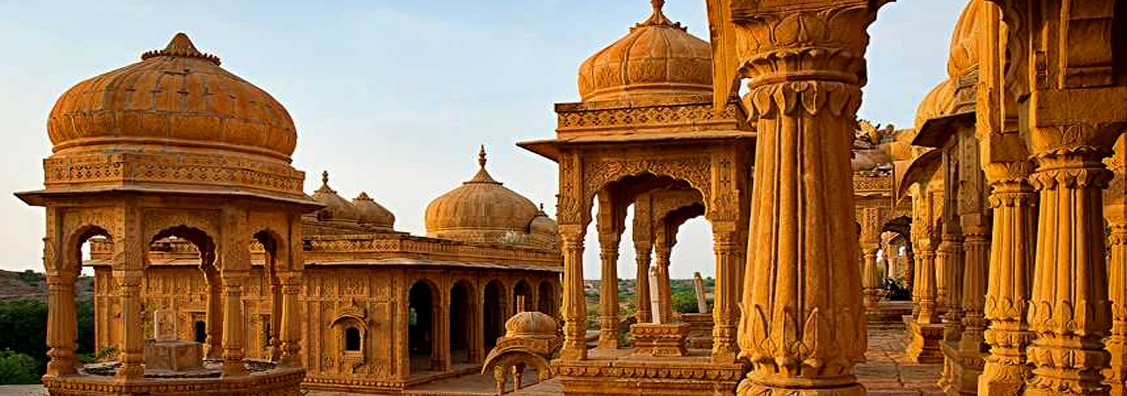

Home / Attractions / Jaisalmer
The History of Jaisalmer has a charm of its own. Like all other cities of Rajasthan, Jaisalmer too has its own glorious past to boast about. History of Jaisalmer draws heavily from the history of the Rajputana. The city is said to be founded by one Raja Rawal Jaisal, a Bhatti Rajput ruler, in approximately 1156 A D. Legends go by that he did it on the behest of a local hermit named Eesaal. The raja choose Trikut hill as the new site for his fort. This was because he thought that his previous abode at Luderwa (16 km from present Jaisalmer) was vulnerable towards possible enemy assault.
Often called 'The Golden City' because it reflects a golden color due to the presence of yellow sandstone structure. A significant part of the population stays in the city only during the four-month of the tourist season and spends their remaining eight months traveling to the neighboring city in search of work.
The famous handicrafts that are available in the city are handmade by the locals mostly using leather as the base material. Other attractive handicrafts include silver jewelry, embroidery on silk and cotton that is weaved by the local women of the village. The wood fossil part or Aakal that is located about 15km from the city holds the history of 180 million years of occurrences in the Thar Desert.
Jaisalmer is a city that has a harmonious blend of both adventure and rich historical heritage. To witness the glory of Indian history and to experience the streaming adventure visit Jaisalmer and enjoy the magic it has to offer.
In medieval times, Jaisalmer continued to be on the focus of the masses because of its location. It falls in the way of one of the two routes, which connected India from Persia, Egypt, Africa and the west. The Bhatti Rajput rulers were still in line. They were the sole guardian of the city and thus mustered enough wealth through taxes levied on the passing caravans, of which there was no scarcity.
For many years Jaisalmer remained out of bound from the foreign rulers partly because of its location and partly because of its relief. In the mid Thirteenth century, Ala-ud-din Khilji, the Turk-Afghan ruler of Delhi laid the siege over the city. He was apparently upset with the Bhatti Rajput rulers because they stopped and looted one of his caravans containing royal coffer which was on its way to Sind. The siege lasted for around 9 long years and when the fall seemed eminent the Rajput womenfolk of the city committed Jauhar (self Immolation to avoid disgrace).
It is said that Duda, the son of Raja Jaisimha, fought vehemently in the battle but was overpowered after the fierce hand to hand combat. He died fighting. His descendants continued to rule the city. Though they had a cordial relation with the Mughal rulers in Delhi, they fought unsuccessfully with Emperor Humayun. Emperor Shah Jahan gave the right of governance to Sabala Simha, who had the royal patronage and had shown remarkable valor to win the Battle of Peshawar.
Jaisalmer is the city of arractions which are below:
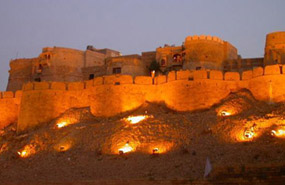
Jaisalmer Fort locally known as Sonar Quila is one of the largest forts in the world located in Jaisalmer City in Rajasthan, India. It was built in 1156 AD by the Bhati Rajput ruler Rao Jaisal, from where it originates its name. This fort is popularly known as the 'Sone Ka Quila (Golden Fort)' by the local people and is one of the most magnificent monuments in the city of Jaisalmer. The fort is standing proudly in the middle of the unending golden sands of Thar Desert, Jaisalmer fort is one of the most prominent tourist attractions of Jaisalmer.
Jaisalmer Fort is a World Heritage Site declared UNESCO under the group Hill Forts of Rajasthan situated in the city of Jaisalmer in Rajasthan, India. Fort was built by the Rajput ruler Rawal Jaisal in 1156 AD, from whom it derives its name. (Rawal Jaisal's son was Shalivahan II; Manj and Bhati Rajputs are descended from him.) Jaisalmer fort stands amidst the sandy expanse of the great Thar Desert, on Trikuta Hill, and has been the scene of many battles. Its massive yellow sandstone walls are a tawny lion color during the day, fading to honey-gold as the sun sets, thereby camouflaging the fort in the yellow desert. For this reason, it is also known as the Sonar Quila or Golden Fort.
Jaisalmer fort is 1,500 ft (460 m) long and 750 ft (230 m) wide and is built on a hill that rises above a height of 250 ft (76 m) above the surrounding countryside. The basement of the fort has a 15 ft (4.6 m) tall wall forming a double line of defense. The bastions of the fort forms a chain about 30 ft (9.1 m). The fort has four entrances to the downside, one of which used to be guarded by cannon.
There is an individual device hoisted on the crest of the fort's walls, and was used to assume the weather. The delicate blend of Islamic and Rajput architectural style will definitely catch the fancy of the eyeballs which looks stunning during the night. The Fort of Jaisalmer survived several attacks by the Muslim rulers like Ala-Uddin-Khilji and Mughal Emperor Humayun. Inside the fort complex tourists can find several architectural buildings which include palaces, houses and temples made up of soft yellow sandstone which looks as the Fort is made up of Gold and its beauty rises with the sunset when it gleam like melting gold. Jaisalmer fort has narrow winding pathways which interlock several parts of the fort. The complex of Jaisalmer fort is so expansive that almost one-quarter of the town's population located in this fort itself.
The most famous splendid structures such as the Maharawals located in front of the Chauhata Square. The foremost attraction of this place is Maharawal's marble throne which is placed over a flight of marble steps. An added famous tourist attraction of this place is a five-storied Tazia tower located head-to-head to the Maharawals palace. This tower was constructed by Muslim craftsmen and is made with decorative Bengali styled roofs.
The one more beauty section in the palace is the Jawahar Palace is among the other tourist attractions of Jaisalmer fort which was the residence of a royal family. This place is famous for its beautiful construction and ornate design which captivate tourist's attention during their visit to this palace. Ganesh Pol, Rang Pol, Bhoota Pol and Hava Pol are the entrance gates of this fort which is known for sculptured beauty and beautiful design. Some havelis are many hundreds of years old. In Jaisalmer, there are many elaborate havelis carved from yellow sandstone. Some of these have many floors and countless rooms, with decorated windows, archways, doors, and balconies.
The most visited places of this fort are the Raj Mahal, The Jain and the Laxmikanth Temples and several other temples and gateways.
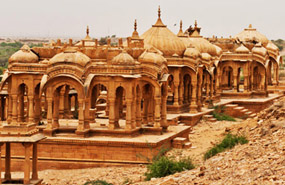
Bada Bagh, Jaisalmer is located on a small hill just outside the city of Jaisalmer. Almost 6km from the city center. The entrance to the cenotaphs is from the bottom of the hill.
The name "Bada Bagh" or "Barabagh" as it is called in Hindi, means a big garden. Although the Cenotaphs stand in the middle of the desert and are completely deprived of any vegetation. But, when they were first constructed, a garden was constructed near them. Maybe the name "Bada Bagh" is derived from the reference to that garden. However, there is no trace of any garden nearby as of today. Nevertheless, it is a peaceful location where golden Cenotaphs rise from golden sand. Each one of these is created in the memory of a king or a queen who passed away. These cenotaphs are called "Chattris" in Hindi, pertaining to their tomb shaped structure at the top.
The tradition of building Chattris at Bada Bagh Jaisalmer started somewhere around the 17th century. And it continued till the 20th century. The first cenotaph is that of Maharaja Jai Singh II .He was the founder of Jaisalmer and ruled from 1688–1743. He did a lot of good work while ruling Jaisalmer, including the building of a dam. Which not only solved the water problems of the otherwise dry territory. But also helped create green patches of vegetation amidst the desert. Upon his death, his son constructed the cenotaph at Bada Bagh, Jaisalmer to commemorate him.
Since then, it became a tradition to set up individual cenotaphs at Bada Bagh, Jaisalmer for each of the king and queen who passed away. The last chattri was that of Maharaja Jawahar Singh. Although, this one remained incomplete. As his son died in the same year when he ascended to the throne and started the construction of the chattri. Somehow, due to his sudden death, the construction of the chattri was believed to be associated with bad luck. And since then the construction of the chattris at Bada Bagh, Jaisalmer were stopped.
The Chattris are all of different sizes. And they are mainly standing in two rows. It looks like the size of the chattris are directly proportional to the power quotient and popularity of the kind or the queen that they belongs to. Which means the more powerful the king, the bigger his chattri.
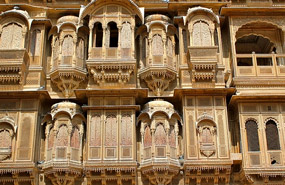
Patwon Ki Haveli is near at Patwa Complex in Jaisalmer. The Patwon Ji ki Haveli is an interesting piece of Architecture and is the most important among the havelis in Jaisalmer. This is precisely because of two things, first that it was the first haveli erected in Jaisalmer and second, that it is not a single haveli but a cluster of 5 small havelis. The first among these havelis was commissioned and constructed in the year 1805 by Guman Chand Patwa and is the biggest and the most ostentatious. It is believed that Patwa was a rich man and was a renowned trader of his time. He could afford and thus ordered the construction of separate stories for each of his 5 sons. These were completed in the span of 50 years. All five houses were constructed in the first 60 years of the 19th century.
The havelis are also known as the 'mansion of brocade merchants'. This name has been given probably because the family dealt in threads of gold and silver used in embroidering dresses. However, there are theories, which claim that these traders made considerable amount of money in Opium smuggling and Money-lending.
This is the largest Haveli in Jaisalmer and stands in a narrow lane. This haveli is presently occupied by the government, which uses it for various purposes. The office of the Archeological Survey of India and State art and craft department is situated in the haveli itself.
Nevertheless, even after these encroachments and abuse you can find a good amount of paintings and mirror-works on the wall. The other important aspects are its gateways and arches. You will notice individual depictions and theme on each and every arch. Although the whole building is made yellow sandstone, the main gateway of the Patwon Ji ki Haveli is in brown color.
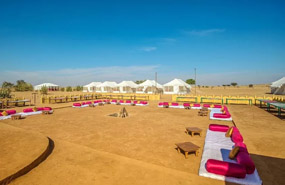
Sam sand dunes, is one of the most authentic desert dune site in whole India, where you will find 30-60 meter tall sand dunes, and many travelers enjoying Desert Safari on camels or jeep, Sam is 45 km west from Jaisalmer city, where you can reach by hiring a can from Jaisalmer city and then stay in one of many desert camps, built in 2-3 km radius of sand dunes.
The best time to reach Sam sand dunes is around evening (sunset) at around 4-7 PM or early morning, during sunrise time of 4 to 6 am. You can book a camel or jeep (which is available at desert camps) to reach.the sunset point, that is 20-30 minutes from the campsite.
The best time to visit Sam or even Jaisalmer is from October to March (Feb) as in the renaming months, all the camps are closed and only few camel riders will be available. As as many travelers love to attend the evening musical program at Sam (at the desert camps), you won't be able to attend them in summer and monsoon months.
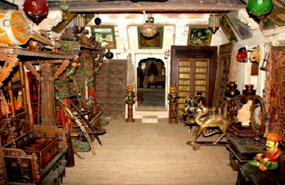
Thar Heritage Museum is located at the main market of the city. Laxmi Narayan Khatri was the founder of this museum. The museum presents you the history, culture, art and architecture of the famous Thar Desert. Sea fossils aging over million years let us in on how the sea eventually became the Thar Desert. The museum houses unique ornaments of the ship of the desert and horses. Documents and coins of Jaisalmer, ancient manuscripts and weapons are some of the collections found in this museum.
This private museum has an intriguing assortment of Jaisalmer artefacts, from turbans, musical instruments, fossils and kitchen equipment to displays on birth, marriage, death and opium customs. It's brought alive by the guided tour you'll get from its founder, local historian and folklorist LN Khatri. Look for the snakes and ladders game that acts as a teaching guide to Hinduism's spiritual journey.
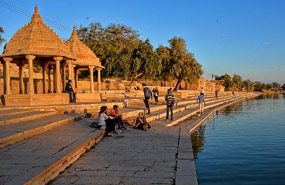
The Gadsisar Lake is one of the most famous tourist places in Jaisalmer which was built by Raja Rawal Jaisal, the first ruler of Jaisalmer. In the later years Maharaja Garisisar Singh rebuilt and revamped the lake. This historic lake is located towards the south of Jaisalmer city and the entrance to the lake is through Tilon-Ki-Pol, a magnificent and artistically carved yellow sandstone archway . The Tilon Ki Pol is adorned with an idol of the Hindu deity Vishnu, installed in the year 1908.
The bank of the Gadsisar lake is surrounded by artistically carved Chattris, Temples, Shrines, and Ghats. Its charm lies in the fact that it was the only source of water for the Jaisalmer city in the olden days. Due to its proximity to Bharatpur, different migratory birds can also be seen on the bank of the lake, adding to its beauty. This is the most popular point to take photographs of Jaisalmer fort early in the morning when the fort looks golden with the first rays of the Sun and also a bird viewing site and a major attraction of Jaisalmer city.The Gadsisar lake is just 2 km away from Jaisalmer railway station.
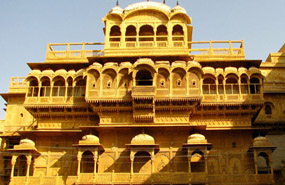
This late-19th-century haveli (traditional, ornately decorated residence), once used as the prime minister's house, is still partly inhabited. It has an extraordinary exterior, dripping with carvings, and the 1st floor has decorative paintings using gold leaf. The left and right wings were the work of two brothers, whose competitive spirits apparently produced this virtuoso work – the two sides are similar, but not identical. Sandstone elephants guard the entrance to what is effectively a shop.
It was commissioned to serve as the residence of Diwan Mohata Nathmal, the then Prime Minister of Jaisalmer. Maharawal Beri Sal commissioned the construction of this Haveli. The architects of this haveli were Hathi and Lulu who happened to be brothers. There is a very interesting story regarding its construction. It is said that the two brothers started building different facets of haveli simultaneously. In those days there were no such instruments, which could keep a track on continuity and thus when this building came up finally it had irregular shape.
Barring that, this haveli is still considered the best in Jaisalmer in terms of grandeur. There are other minute details worth appreciation. For example there are two Elephants made of yellow stone. These life-size replicas have been put in front of the main entrance so that it looks as if they are guarding the Haveli. Other than these, there are pictures engraved on pillars and walls. These consist of Horses, Cattle, and depiction of Flora among other things. But the most interesting aspect of this haveli is the drawing of modern amenities such as cars, fans etc. It is said and believed that the Architect brothers dint see these things ever in their life and engraved it with mere help of their descriptions given by people who had seen it.
Thus the architecture present in this haveli is quite different from the one popular in other parts of Jaisalmer. The workmanship of Jaisalmer havelis is an amalgam of both Rajput architecture as well as Islamic art that was imported via the traders' caravan through the desert.
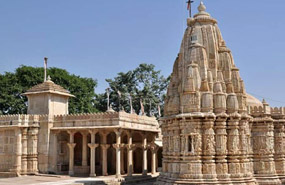
Jain Temples situated in the Jaisalmer Fort are a must visit site in Jaisalmer, Rajasthan. You will find these temples to be very old and high pilgrimage as well as archeological value attached to them. These are a group of Jain temples dating back 12th and 15th centuries and are dedicated to various Jain Tirthankars (Hermits). On the walls of the temples, you can find animal & human figures, carved in famous Dilwara style.
These temples are built in the Dilwara style that is famous all over the world for its architecture. The style got its name from the famous 'Dilwara Temples' situated on Mount Abu, a famous Hill station and pilgrimage destination in Rajasthan. The Jain temples in the Jaisalmer Fort are dedicated to Rikhabdevji and Shambhavdev Ji, the famous Jain hermits known as 'Tirthankars'. Like all other structures in Jaisalmer, these temples are craved of yellow sandstones. The beautifully carves decorations on the wall will give you divine peace. The Astapadhi Temples that are situated in the same complex are a must visit too.
The temple complex is open through out the morning till 12noon, for the visitors. So try to get up a bit early or you might miss this splendor. The campus also contain Gyan Bhandar library. Well if you are a student of comparative archeology or otherwise, the library will prove to be a good place to prowl as it contains some of the rare manuscripts available in India.
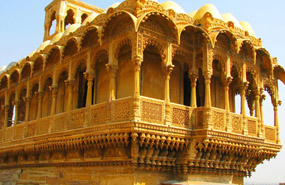
Salim Singh ki haveli has been built on the remains of an older haveli built in the late 17th century. It is situated in the heart of Jaisalmer, Near Railway Station. The new building was built in the year 1815 and was occupied by the Mehta family of Jaisalmer. They were the most influential family of their time. This haveli was commissioned by Salim Singh, the then Prime Minister of the kingdom when Jaisalmer was the capital.
The haveli has a distinct architecture. The roof has been constructed in the form of Peacock. The haveli is situated beside the hills near the Jaisalmer Fort. People claim that Salim Singh made two additional floors in order to make it as high as the fort but the Maharaja did not take this attempt in good spirit. He ordered the extra floors to be torn down. Nevertheless we do not find enough evidence to corroborate the story.
Like other havelis in Jaisalmer, this too has tuskers guarding the gateways. These are made of sand stones and look very close to the original in appearance. The haveli consists of as many as 38 balconies and they all have distinct designs for themselves. The front facet of the haveli resembles ship stern and thus this haveli is also sometimes referred as Jahazmahal.
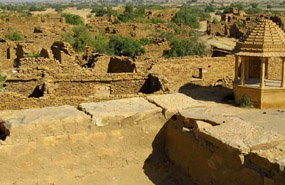
Kuldhara is one of the most haunted village in India, The deserted, narrow and ancient streets of Kuldhara are the source of myths, spooky folklore ,and stories of ghosts and paranormal activity.
17 kilometers from Jaisalmer, nestles a town called Kuldhara, which was once prosperous but now, it lies in ruins and all that is left are various open houses in the state of despair. At first sight, this curse ghost town, Kuldhara, gets the thinking caps on and immediately increases people's faith in metaphysical and the paranormal activities.
The story goes like this, Once this village was home to around 1,500 Paliwal Brahmins, which has lived in this community for more than five centuries peacefully and comfortable. But one night, the entire population, including 85 villages, vanished overnight in the dark and left it with a curse that still haunts it. And nobody knows where they left. For centuries, people have been thinking about what might be the reason that the people fled overnight.
Rumors say that Salim Singh, the evil prime minister, who was known for his sinister practice of collecting the tax, set his eyes on a girl of Paliwal Brahmins and decided to marry without her consent. Salim Singh threatened the village that if the marriage doesn't happen, villagers will face the worse consequences. Instead of giving approval, the villagers asked for some time and then left their houses overnight. But before living, they cursed the village that nobody can inhabit the villages ever. Some stories even say that heavy taxes were levied on Paliwal community and as a result, they had no option, but to vacate and just disappear from the reach of the ruler. Even after so many years of this accident, the village remains true to the curse as residents of Jaisalmer tried to stay here but they didn't succeed.
Many strange and unnatural activities that keep on happening at this place has gathered eyeballs of many ghost hunters and intrepid paranormal societies. People from different part of the world visit Kuldhara to see the dark and spooky side of the Rajasthan and unveil mysterious secrets, which in just one night made this place godforsaken for rest of the years.
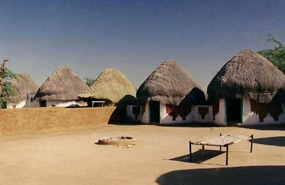
It is famous for its sand dunes, Khuri is a small village about 50 km south-west of Jaisalmer in Rajasthan. Khuri is less crowded and provides a more enjoyable experience. Yet to make a prominent mark on the tourist map, Khuri has escaped commercialization and the hordes that descend to visit the sand dunes. Khuri Sand Dunes of Thar Desert can be reached from the village within 30 minutes or so. Sam Sand Dunes are about 38 km from Khuri and are famous for camel safaris.
Signs of development are visible in Khuri as more people discover it. Locals have also been quick to exploit the increasing popularity of the village. Staying in houses made of mud and straws is the USP of several homestays in Khuri. Visitors to Khuri split their sojourn into a night in the village and one in the desert. A night in the desert offers an ideal setting to star gaze. To entice the visitors, bonfires accompanied with folk songs and Kalbeliya dance routines are common Camel races and camel polo is also arranged for the entertainment of the travelers. There really is not much for you to do in Khuri. Days are spent idling, partaking of authentic Rajasthani meals, witnessing sunrises and sunsets from the sand dunes. If you are interested in birding or wildlife in general, Khuri offers vantage points to watch the Demoiselle crane.
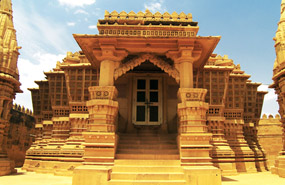
It is outskirt of Jaisalmer, 16 km away from City, The Lodurva is the ancient capital of Bhattis Rajputs and was once a flourishing city but lost most of the splendor when the Bhattis shifted their capital to Jaisalmer. Nevertheless this place is a major tourist attraction and attracts a lot of attention due to ruins of Jain temples. The most mesmerizing experience will be the peacock dance amid exotic Lodurva ruins. Yes, Peacocks are a great pull and they are in plenty here.
Lodurva is also known for its Jain temples. The temples are made of bright yellow sandstones. Though in ruins, the splendors of these Jain temples are clearly visible. You will find temple walls decorated with the pictures of Lord Parsvanath, the 23rd Jain Tirthankar. The beautiful Jaali works make these temples a piece of marvel. You will notice the splendid and dominating arch in the main temple building. These arches are typical of the Dilwara style of temple architecture.
